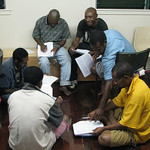 In early April, as part of Americans for the Arts’ Emerging Leaders blog salon, Gregory Burbage posted an article on small group organization in mega-churches and the lessons to be learned from them: Group Therapy in the Arts. The point he was presenting is that huge churches (the one he cited has a membership of 24,000!) organize (and grow) themselves through the establishment of small support groups unified around interests or age. This is a model with which I am very familiar as a result of my extended (and long since ended) sojourn in Southern Baptistdom. I have always been impressed by the cohesion and self-organization made possible by this approach to structure. It is relatively simple and can be highly effective in supporting growth in churches. It is also a model that has much to offer in developing, growing, and maintaining relationships with people whom the arts serve.
In early April, as part of Americans for the Arts’ Emerging Leaders blog salon, Gregory Burbage posted an article on small group organization in mega-churches and the lessons to be learned from them: Group Therapy in the Arts. The point he was presenting is that huge churches (the one he cited has a membership of 24,000!) organize (and grow) themselves through the establishment of small support groups unified around interests or age. This is a model with which I am very familiar as a result of my extended (and long since ended) sojourn in Southern Baptistdom. I have always been impressed by the cohesion and self-organization made possible by this approach to structure. It is relatively simple and can be highly effective in supporting growth in churches. It is also a model that has much to offer in developing, growing, and maintaining relationships with people whom the arts serve.
Mr. Burbage points to groups of which he is a member. For arts administrators, the mutual therapy possible via a small group is valuable (if not essential). It can be a lonely, if not discouraging, life. Having a group of peers with whom you can “let your hair down” and talk about the Board, the artistic director, (the executive director), or the vagaries of artists is a means of maintaining sanity. I know that the Association of Arts Administration Educators’ annual conference serves that role for me and many of my colleagues. (Come join us at the end of May, we’re a very entertaining, if somewhat wacky group. Conference info is here.)
But what Mr. Burbage’s post really got me thinking about was the potential of small groups as a means of community engagement. Imagine if there were hundreds of “cells” of “opera people” or “orchestra people” who gathered on a semi-regular basis to talk about the arts and other interests. Such small groups could eventually be self-organizing. (Well, maybe not totally self-sufficient, but they need not have their hands held by arts organization staff at every gathering.) Technology could make these simpler to arrange than used to be the case. They could also provide a mechanism for dialogue–communication and feedback–with the organization.
What I’m talking about here is a bit like a book club or supper club with the arts organization or the art form as the common bond. This is more than pre-curtain talks. It is an ongoing mechanism that is largely implemented by the participants. It is a structure that could support my goals for the arts–substantive, lasting engagement.
Anyone out there got a good example? I’d love to share it with people.
Engage!
Doug
Photo: ![]()
![]()
![]() Some rights reserved by kahunapulej
Some rights reserved by kahunapulej

You might want to read “Cathedral and the Bazaar” — about open source software but relevant to community organizing — and some of the work published by the Asset Based Community Development Institute (_Leading by stepping back_) as it might touch off some thinking about how to engage “audiences” beyond just coming to events, along the lines you are indicating here. Obviously, the Internet through listservs and blogs links people of common interests beyond the spatial, but is there the opportunity to do what you suggest in association with actual places and institutions. I would argue yes, but it also requires a much bigger change within the organization in terms of how much “power” to shape the organization that it “cedes” to the audience. (I am an urban planner and make the same general points about the planning process, civic engagement, and participatory democracy.)